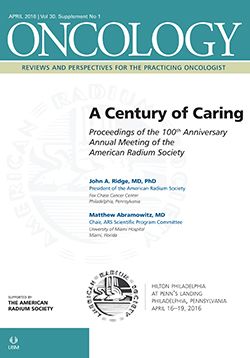(S023) The Radium Chemical Company: 1913–1981
The Standard Chemical Company was organized in 1911 to produce and sell radium. It was the first American company to do so. Most of the radium went to Europe, as there was little demand in America.
Roger F. Robison, MD; Good Samaritan Hospital
The Standard Chemical Company was organized in 1911 to produce and sell radium. It was the first American company to do so. Most of the radium went to Europe, as there was little demand in America. Therefore, in 1913, Standard formed a subsidiary, Radium Chemical Company (RCC), for marketing and sales promotion. The RCC published a monthly journal, Radium, during 1913–1925 and supported the establishment of the American Radium Society. They also manufactured sealed radium sources and brachytherapy devices. During World War I (1914–1918), the production of luminous paint for military equipment and timepieces utilized 50% of all of the radium produced by Standard and its competitors. Yearly sales of radioluminescent watches and clocks skyrocketed from 8,500 in 1913 to 4 million in 1920.
Belgium Radium took over the market in 1922–1923. Standard ceased mining operations and was slowly liquidated during 1928–1933. However, the RCC continued with paint production, dial painting, and the manufacturing of sealed sources and devices. The manufacturing site in Queens, NY was shut down in 1981. When it was demolished during 1988–1995, the Environmental Protection Agency found 10,000 radium needles, 120 grams of radium, 189 Ci of radioactive waste, 92 tons and 197 gallons of nonradioactive hazardous waste, and 812 tons of radioactive soil and debris.
Workers at Radium Dial (RD), an RCC subsidiary, utilized the desks in an old school in Ottawa, IL. By 1925, they were painting 1 million dials a year. That year, the lawsuits began against US Radium in NJ, which had noted employee deaths from radium during 1922–1924. RD began secretly testing their employees and fired anyone who was sick. After six deaths, RD liquidated and moved a few blocks away to continue business as Luminous Processes (LP). LP was shut down by the Nuclear Regulatory Commission in 1978 and tried to donate their desks to a local Catholic school.
Proceedings of the 98th Annual Meeting of the American Radium Society - americanradiumsociety.org

Targeted Therapy First Strategy Reduces Need for Chemotherapy in Newly Diagnosed LBCL
December 7th 2025Lenalidomide, tafasitamab, rituximab, and acalabrutinib alone may allow 57% of patients with newly diagnosed LBCL to receive less than the standard number of chemotherapy cycles without compromising curative potential.